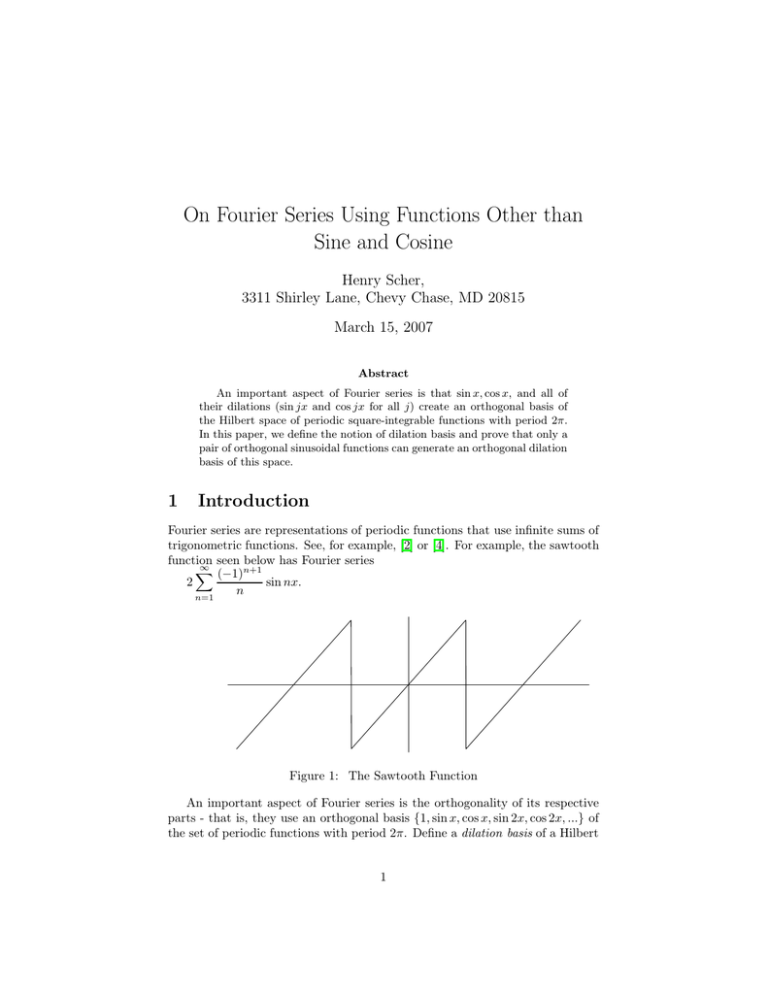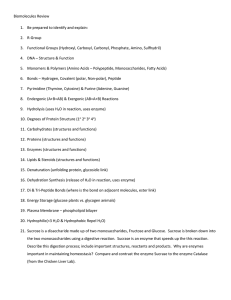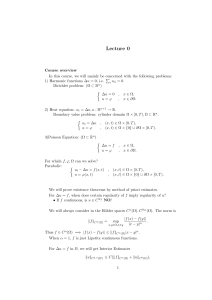On Fourier Series Using Functions Other than Sine and Cosine Henry Scher,
advertisement

On Fourier Series Using Functions Other than
Sine and Cosine
Henry Scher,
3311 Shirley Lane, Chevy Chase, MD 20815
March 15, 2007
Abstract
An important aspect of Fourier series is that sin x, cos x, and all of
their dilations (sin jx and cos jx for all j) create an orthogonal basis of
the Hilbert space of periodic square-integrable functions with period 2π.
In this paper, we define the notion of dilation basis and prove that only a
pair of orthogonal sinusoidal functions can generate an orthogonal dilation
basis of this space.
1
Introduction
Fourier series are representations of periodic functions that use infinite sums of
trigonometric functions. See, for example, [2] or [4]. For example, the sawtooth
function seen below has Fourier series
∞
X
(−1)n+1
sin nx.
2
n
n=1
Figure 1: The Sawtooth Function
An important aspect of Fourier series is the orthogonality of its respective
parts - that is, they use an orthogonal basis {1, sin x, cos x, sin 2x, cos 2x, ...} of
the set of periodic functions with period 2π. Define a dilation basis of a Hilbert
1
space of square-integrable functions to be a set of functions f1 (x), f2 (x), ..., fn (x)
such that
{f1 (x), f2 (x), ..., fn (x), f1 (2x), ..., fn (2x), ..., f1 (jx), ..., fn (jx), ...}
is a Hilbert space basis. Note: we may allow a constant, as its dilations are
the same constant function, and repeated elements do not add to a set. This
leads to the question - are there any other orthogonal dilation bases for the
real-valued square-integrable periodic functions? The answer is that all orthogonal dilation bases of the periodic functions with common period 2π consist
of two orthogonal sinusoidal functions and a constant - only sets of the form
{c1 , a1 sin x + b1 cos x, c2 (a1 cos x − b1 sin x)} can create an orthogonal dilation
basis.
We see a similar situation in the theory of wavelets (see [1] or [3]), where
often a function ψ(x) ∈ L2 (R) is chosen such that the family of functions
ψm,n (x) = 2m/2 ψ(2m x − n), with m, n ranging through the integers, forms an
orthogonal basis for L2 (R). There, however, the dilations are by powers of 2,
rather than by all positive integers.
2
Orthogonality
To begin to analyze this question, we must first look at orthogonality. Within
the set of periodic functions, two functions f (x) and g(x) are considered orthogonal if
Z 2π
f (x)g(x)dx = 0.
(1)
hf, gi =
0
The integral is well-known to give an inner product for functions on [0, 2π]. If
we allowed complex-valued functions, then we would have to take the complex
conjugate of g(x) in the integral. For simplicity, we are restricting to real-valued
functions.
In the question given above, every distinct pair of functions in the set
f1 (x), f1 (2x), ..., f1 (jx), ... must be orthogonal. If hf (jx), f (kx)i = 0 for all
j 6= k, we say that f is dilation-orthogonal. An interesting question, then, is
whether this is possible for functions that are not translations of the sin and cos
functions.
The answer is yes - a simple example being sin x + cos 2x. In fact, there is an
infinite variety of functions (for example, sin x+cos ax for all positive integers a)
that are dilation-orthogonal. However, this property is not sufficient to create
the basis, as shown by the example in the next section.
Proposition 1 Let f (x) be a dilation-orthogonal square-integrable periodic funcR 2π
tion with period 2π. Then 0 f (x) dx = 0.
Proof Let f (x) have the Fourier series expansion
f (x) = a0 +
∞
X
an cos nx + bn sin nx.
n=1
2
The integral in the proposition is 0 if and only if a0 = 0. As f (x) is dilationorthogonal,
0 = hf (kx), f (x)i
for all integers k > 1. Therefore,
0 = a20 +
∞
X
an akn + bn bkn .
n=1
Since f is square-integrable,
∞
X
a2n + b2n
n=1
converges. The Cauchy-Schwarz inequality states that
2
∞
∞
∞
X
X
X
an akn ≤
a2n
a2kn .
n=1
n=1
n=1
The right side is equal to a finite number multiplied by a number that approaches
0 as k → ∞, so the left side converges to 0 as k → ∞. This works similarly for
the bn ’s. However,
∞
X
a20 = −
an akn + bn bkn .
n=1
Since a0 is independent of k and the right side can be arbitrarily small, a0 = 0.
This shows that within any orthogonal dilation basis for the set of all squareintegrable periodic functions, a nonzero constant must be included, since the
constant functions are periodic but cannot be generated any other way by an
orthogonal dilation basis. The other functions are all orthogonal to a constant,
and so must have integral 0. We can now restrict ourselves to looking at a basis of
the set of 0-integral functions, as any basis of the entire set of periodic functions
corresponds to a basis of 0-integral functions by removal of the constant function.
3
An Example
Not every function with dilation-orthogonality can be a part of an orthogonal
dilation basis. For example, sin x+cos 2x cannot be part of a basis generated by
a dilation basis. If it could be, then it could not be fi (jx), with j > 1, since the
period of fi (x) would be 2π/j (instead of 2π). Therefore, sin x + cos 2x = fi0 (x)
for some i0 . We can expand cos(x) in terms of the basis. This yields the
following:
n X
∞
X
cos x =
aij fi (jx)
(2)
i=1 j=1
cos 2x =
n X
∞
X
i=1 j=1
3
aij fi (2jx)
(3)
Z
2π
(sin x + cos 2x) cos 2xdx =
0
Z
2π
(sin x + cos 2x)
0
n X
∞
X
aij fi (2jx)dx
(4)
i=1 j=1
Since fi0 = sin x + cos 2x,
π=
n X
∞
X
aij
i=1 j=1
Z
2π
fi (2jx)fi0 (x)dx = 0
(5)
0
because of the mutual orthogonality of every member of the basis. This is a
contradiction, so sin x + cos 2x cannot be in such a basis. This proof can be
applied to all functions that are finite sums of sines and cosines, except those
that are of the form a cos x + b sin x, or, equivalently, A sin(x + B). The next
section shows that even infinite sums do not work.
4
Main Result
Theorem 1 Let {f1 (x), f2 (x), ..., fn (x)} be an orthogonal dilation basis of the
set of square-integrable periodic functions on [0, 2π] with integral 0. Then n = 2;
moreover, f1 (x) = a1 sin x + b1 cos x and f2 (x) = c(a1 cos x − b1 sin x) for some
constants a1 , b1 , and c.
Proof Since we are assuming that {fi (jx)}i,j is a basis, there is an expansion
sin(x) =
n X
∞
X
aij fi (jx).
i=1 j=1
The coefficients aij are given by
hsin x, fi (jx)i
aij =
=
hfi (jx), fi (jx)i
R 2π
0
sin x fi (jx)dx
,
R 2π 2
0 fi (jx)dx
(6)
since an element in a Hilbert space with an orthogonal basis is equal to the sum
of its projections on the basis vectors.
Expand fi (x) in a Fourier series:
fi (x) =
∞
X
Aik cos kx + Bik sin kx.
k=1
Let us look at the integral in the numerator of Equation (6). When j > 1,
!
Z 2π
Z 2π
∞
X
sin x
Aik cos jkx + Bik sin jkx dx
(7)
sin x fi (jx)dx =
0
0
=
∞ Z
X
k=1
k=1
2π
sin x (Aik cos jkx + Bik sin jkx) dx =
0
∞
X
k=1
4
0 = 0,
(8)
since sin x is orthogonal to sin jx and cos jx for j ≥ 2. It follows that aij = 0
when j ≥ 2. Therefore,
n
X
sin x =
di fi (x)
(9)
i=1
for some constants di .
Similarly,
cos x =
n
X
ci fi (x)
(10)
i=1
for some constants ci .
Now, as sin x and cos x do form an orthogonal dilation basis, and because
we have already shown that there is no constant term in the Fourier series, we
can say that
∞
X
f1 (x) =
aj cos jx + bj sin jx.
(11)
j=1
Then
aj =
=
=
If j > 1, then
1
π
Z
1
π
Z
2π
f1 (x) cos jx dx
(12)
0
2π
f1 (x)(
0
n
X
ci fi (jx))
(13)
i=1
Z 2π
n
1X
ci
f1 (x)fi (jx)dx.
π i=1
0
aj =
n
X
0 = 0.
(14)
i=1
A similar argument can be made for bj - that is, bj = 0 for all j > 1. Therefore,
f1 (x) = a1 cos x + b1 sin x = A sin(x + B)
(15)
for some a1 , b1 , A, and B.
A similar argument can be made for each of the fi (x), so each is a linear
combination of sin x and cos x.
However, that means that each of these functions is a linear combination of
sin x and cos x. Since this is a two-dimensional space, there can be only two
functions, f1 and f2 . The fact that f1 are f2 are orthogonal easily implies the
theorem. This completes the proof.
Putting the constant function back in, as described at the end of section 2,
we obtain the following.
Corollary 1 Let f1 (x), f2 (x), ..., fn (x) be an orthogonal dilation basis of the
set of square-integrable periodic functions on [0, 2π]. Then n = 3, and the
functions are given, up to order, by f1 (x) = c1 , f2 (x) = a1 sin x + b1 cos x, and
f2 (x) = c2 (a1 cos x − b1 sin x) for some constants c1 , a1 , b1 , and c2 .
5
References
[1] I. Daubechies, Ten lectures on wavelets, CBMS-NSF Regional Conference
Series in Applied Mathematics, 61, Society for Industrial and Applied
Mathematics, Philadelphia, PA, 1992.
[2] Y. Katznelson, An introduction to harmonic analysis, 3rd edition, Cambridge Univ. Press, 2004.
[3] G. Walter and X. Shen, Wavelets and other orthogonal systems, 2nd edition,
Chapman & Hall/CRC, 2001.
[4] A. Zygmund, Trigonometric series, 3rd edition, Cambridge Univ. Press,
2003.
6

